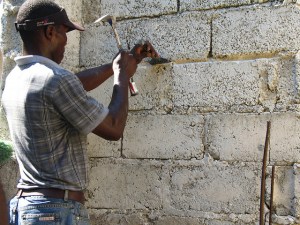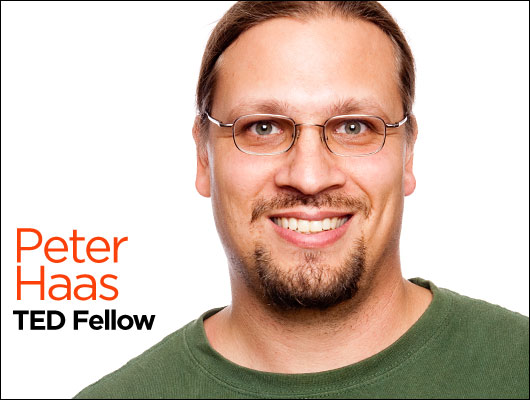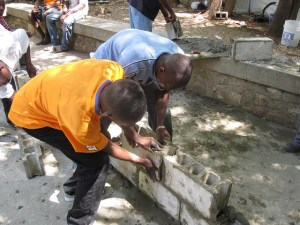Interactive Fellows Friday Feature!
Join the conversation by answering Fellows’ weekly questions via Facebook. This week, Peter asks:
How can we move the discussion of NGO efficacy beyond just the numbers (total number of people served versus overhead costs, etc) towards the long term impacts of projects?
Click here to respond!
Many NGOs support infrastructure development to communities in need. What’s unique about what AIDG does?
AIDG is one of the few groups that’s focused on supporting small and medium enterprises, while also helping people doing infrastructure projects have access to high quality engineering expertise. We connect entrepreneurs with engineers who can help them make a better product and get closer to achieving international standards.
We also provide trainings in different aspects of engineering to the general public as part of our broader outreach. In Haiti, we’ve been doing a very large project for engineering training as a result of the earthquake in January of 2010. We started a program to train masons in confined masonry construction, a type of construction that makes buildings more resistant to collapse. So far, we’ve trained 3,000 masons out of 12,000 in the country.
You studied philosophy and psychology in school. How did you gain expertise in confined masonry, engineering, and business?
In my TED talk I discussed confined masonry, but I’m not an expert on it. I’m not an expert on engineering or business, either. What we do at AIDG is bring in other people who have expertise, and rely on them to do the trainings. What I think I’m able to do is see clearly what the deficiencies in a region are. I have an eye for what are good businesses to try to support, and what will fail.
I spent a year traveling around the world, volunteering for different NGOs. Because of my previous work on a horse ranch organic farm, I was able to repair things that people in the villages I traveled to weren’t sure how to repair. I realized, through that experience, that the typical NGO model really doesn’t work for giving village-scale infrastructure. There’s no economic incentive to preserve upkeep knowledge. People who have the knowledge of how to repair things generally get better jobs and move away. And people don’t treat the donation of an infrastructure project the same way they treat infrastructure that they’ve had to save up for and buy.
It got me wondering, “How do you institutionalize the knowledge of how to repair things?” And, “How do you make sure these projects that are done out in villages actually succeed?”
In the US or Europe, small businesses often do infrastructure repair work. I realized developing countries needed small businesses like that to do the same type of work. But there is a comparative lack of small businesses doing infrastructure work in developing economies. And there are a lot of barriers for early-stage entrepreneurs that don’t exist in the developed world.
What are some of those barriers entrepreneurs face?
Access to capital in the small and medium enterprise (SME) range is a huge barrier. People in developing economies have a lot of access to microcredit. But microcredit is not going to let you buy a truck and hire 10 guys to go put in telephone poles. Microcredit won’t give you an advance on several hundred thousand dollars for materials for a project. I realized there was need for midscale credit.
We realized there was a need for grant funding as well. In the US, if you want to start a small corporation or an LLC, it will take you a hundred-something dollars, and some time on the Internet. If you want to start a business in Guatemala, it can take you up to six months and $3,000 to $4,000 worth of fees and fines. It’s just not a starting point for most entrepreneurs.
So we realized there was an opportunity for an NGO that, instead of doing projects directly, helps start businesses that could do these projects.
Why didn’t you just start a SME-lending institution?
That is something that was and is starting to be covered. But we’re trying to identify talent that really is at a stage where they aren’t even able to access that current early-stage SME financing. A lot of people, who are just starting up, lack the money to even incorporate to have a company. Most SME lenders are looking for two or three years of experience.
We’re trying to be a seed funder that can pipeline into the other SME finance mechanisms.
How do you know which are the best businesses to support?
Really, for identifying the highest potential business, we look towards our experience working with the general population, and understanding what the needs are within the general population for appropriate technology.
We’ve done outreach projects over the past couple years that have really led us to understand what appropriate technologies work in villages, and what appropriate technologies will fail. Usually the appropriate technologies that fail in villages are ones that lose sight of the end user — those that lose sight of what people are looking for in a product. Instead, they get wrapped up in the technology or cool service that they could provide people.
How did the TED Fellowship impact you?
TED gave me a lot of access to potential funders that I never had before. I’m very grateful to TED for that opportunity.
Talking on the TED stage in 2010 gave me the opportunity to share with people the importance of proper building practices in preventing major disasters. I spoke about the earthquake in Haiti and the disaster of engineering.
After the 2010 earthquake, we inspected over 1500 buildings as part of sessions with the UN and the Ministry of Public Works. We saw the same failure points again and again. Those failure points were coming from the fact that people providing the construction services weren’t trained in confined masonry techniques, which would have made the buildings much safer during the quake.
The more that that message can spread to people in developing countries, who are living in seismic zones, the safer people can be.
You’ve been described as an “inveterate tinkerer.” What can we expect from you next on that front?
In my spare time I’m a closet designer and inventor. I’m hoping that some day I’ll be able to share more of that with the world. I’ve started a side company called Fifty Frogs that’s an invention company.
I started Fifty Frogs hoping to foster the development of leapfrog products that have applications both in developing and developed economies. To use the capability of producing products to scale for developed countries as a way of getting access to be available for people in developing economies.
I really think there are a lot of potential products right now that are being overlooked, that have applications both in emerging markets and in established developed world markets — things like housing products, green products, and camping products. There’s a lot out there that bridge what people’s needs are in emerging markets and what people’s needs are in developed markets, that aren’t being designed right now. People are really focusing on one or the other, and not the crossover between the two.
As a tinkerer, what tool best describes you?
I would say a drawknife. A drawknife is used to carve and shape wood. You have to be very careful with a drawknife, because it can easily break things, but it also helps you discover what forms are sitting in the wood, waiting to be carved out. So it is a tool as much of discovery as it is of creation.
That’s what I hope I can be: a tool that helps the forms that are already out there, emerge.
You’ve said you’re repeatedly astounded by people who tell you some of the things you try to do are “impossible.” What’s a small step a person could take to challenge their perceptions of the possible?
I think one of the most important things is for people to travel and step outside of their comfort zones, and really understand other people’s experiences and lives. I do judging for the EPA for the People, Prosperity and Planet competition. One of the routine failure points for university teams who are trying to design solutions for the world, are the ones who never get a chance to go out of the country. They never really see the lives of the people that they’re trying to design a product for. I think it’s really vital to understand that there’s a wide array of living experiences out there.
There are many aspiring social entrepreneurs out there who are trying to take their passion and ideas to the next level. What is one piece of advice you would give to them based on your own experiences and successes? Learn more about how to become a great social entrepreneur from all of the TED Fellows on the Case Foundation blog.
The most important thing is to spend some time actually working with other organizations to understand the day-to-day grind behind running an organization, before you make the plunge. It’s very easy to have an idea and to pursue it for two or three weeks. But when you have to actually take the idea and turn it into a sustainable organization, that’s where I see a lot of people’s dreams fall short.
Getting experience in day-to-day management of an organization, and how to build it and run it, is the most vital thing for the success of any social entrepreneur.


Comments (5)
Pingback: Break it down and make it: Fellows Friday with Dominic Muren | TEDFellows Blog
Pingback: Break it down and make it: Fellows Friday with Dominic Muren | Krantenkoppen Tech
Pingback: TED Fellows 2012 申请现已开始 « 在武汉